Great Mosque of Cordoba Plan Drawing

Introduction
Mosque Córdoba is the almost important case of Islamic architecture in the W. Combines both the Umayyad style Spain as Gothic, Renaissance and Bizarre styles of the Christian tradition considering of its long history and evolution over time.
The complex is located in the historic city centre, nearly the Guadalquivir River and next to the Roman bridge. At effectually the Alcázar de los Reyes Cristianos and the Archaeological Museum it is as well located.
Mosque Córdoba is office of the Route of the Caliphate, which connects the cities of Granada and Córdoba across the province of Jaen, linking country that witnessed during years of conflict between Christians and Muslims.

Route of the Caliphate
The site of the mosque has been used throughout history as a place of worship. Visigothic narrowing the Basilica of San Vicente. Later Muslims bought part of the country and it congenital the first mosque. The infinite was then shared by Christians and Muslims, until Rahman I bought the whole site, destroying the existing building and building the commencement Mezquita Alhama, or main mosque in the city. As proof of these events are nevertheless today some remains of the Visigoth basilica built in the first role of the structure of Abderramán I.
The successor of Abderramán I, his son Hisham I, added his starting time mosque minaret quadrangular. Hixem I as well ordered the structure of galleries for prayer women in the courtyard and the first stack of ablutions. With these additions was set the master mosque in Córdoba.
Over the years, the increase of the faithful and will monumentalizar all, the mosque was expanded significantly to reach its current configuration.
Cathedral Córdoba, of the 16 century, was already designed from origin to respect the expansion of the mosque carried out past Al-Hakam II. Carlos 5 and Bishop Manrique agreed on the need to preserve the mosque for its dandy architectural value. Thus, in 1523, it began the construction of the cathedral, conducted by builder Hernán Ruiz in extensions and Mansur Rahman I Mosque. After the expiry of Hernán Ruiz, succeeded him in the work his son, his grandson, and later, Juan de Ochoa. The structure of the cathedral, therefore, runs well-nigh 200 years of history and architectural evolution, hosting both Gothic features such equally Renaissance and protobarrocos.
In 1930, following excavations led by architect Felix Hernandez, the remains of the episcopal complex centuries Four to 6 in the basement of the mosque-cathedral were institute. In this way the Visigoth site and the exact location of the Basilica of San Vicente Martyr was demonstrated.
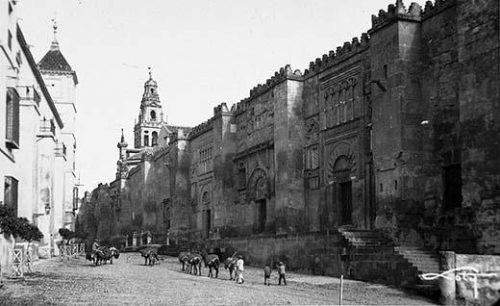
The mosque in 1920
- VI century Visigoth basilica of San Vicente.
- 784-786: Sultan Abderramán I.
- 790: Hisham I.
- 833-852: Expansion of Abbderramán II.
- 951-952: Expansion of Abderramán 3.
- 961-966: Expansion of Al-Hakam II.
- 987: Extension of Almanzor.
- 1236: Recapture of Córdoba past Fernando III of Castile.
- 1238: Consecration of the temple and cathedral.
- 1523: Commencement of construction of Renaissance Plateresque Basilica.
Location
The mosque is located at No.1 Street Cardenal Herrero, located in the celebrated center of the city of Cordoba, Spain. The set is limited past the street Torrijos, Cardenal Herrero Street, Street Meson del Sol and Calle Corregidor Luis de la Cerda. Bus lines with stops near the monument are the 4, five, 6 and 7.
Concept
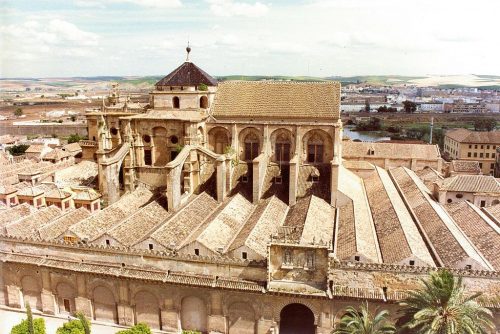
undefined
The mosque in Córdoba is the best example of Muslim architecture, next to Alhambra of Granada, in the Western world. In this complex you lot can run across the extensive life and history of architecture. Moreover, it is a magnificent case of compages combining two religions, Muslim and Christian. Despite the reconquista, Christian leaders were able to appreciate the artistic and architectural value of the temple, making him a place for his faith by inserting a cathedral in the eye and respecting the rest of the gear up. In this mode nosotros tin can encounter today the combination and contrast of these two architectural styles and the unlike characteristics of the places of worship of all religions.
I of the master features of the mosques is the placement of the mihrab, the sanctuary qibla pointing in the direction of Mecca. In the case of the Mosque of Córdoba, information technology faces south. This could be due to the terrain along the river Guadalquivir, to the influence of the Great Mosque of Damascus, Syrian arab republic; or the location of the Roman Cardo of Córdoba.
Spaces
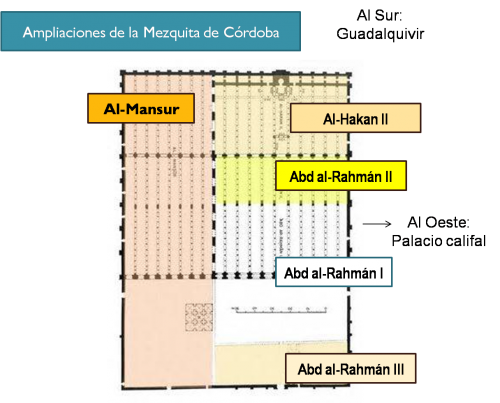
undefined
The mosque in Córdoba, to 23,400 m2, was the 2d largest in the world after that of Mecca, until in 1588 the Blue Mosque in Istanbul exceeded. The mosque is divided into two distinct parts. The first part, patio or portico sahn houses the minaret below the Renaissance tower, which is the merely intervention that Abd al-Rahman Three was in the mosque. This part also is the prayer room or haram. The second function of the mosque is the interior of information technology. Information technology is characterized by the set of columns and arches that define bicolor. These make a very distinctive colour and formal whole. The inner area is divided into v parts, each corresponding to the successive enlargements that the mosque has had throughout its history.
The Orange Courtyard
The courtyard has changed and expanded with the various reforms and extensions of the mosque. Today has measures 130 meters long and 50 meters wide. The most of import development to the north, there was at the time of Abd al-Rahman Three, taking down the minaret of Hisham I, and lateral extension of Mansur. This area worked in Islamic times as a identify for public events such equally teaching and administration of justice. In the early days of the Oratory arches they were open, creating a patio. Afterward came the structure of galleries Abderramán I and the minaret and ablutions hall of Hisham I. The cloisters are today due to a remodeling of the sixteenth century carried out past Bishop Martin Fernandez de Angulo, led by architect Hernán Ruiz I. Nether the patio of orangish trees a large cistern that provides and ensures the necessary water for the purification of Muslims before inbound the mosque is located. There is the evidence of the existence of orange trees in the courtyard from the fifteenth century, but already in the 13 I still had palm copse on information technology. In the eighteenth century olive and cypress trees they were added. The courtyard also has two sources, Santa María (XVII century) and Cinnamon (1752).
The Minaret
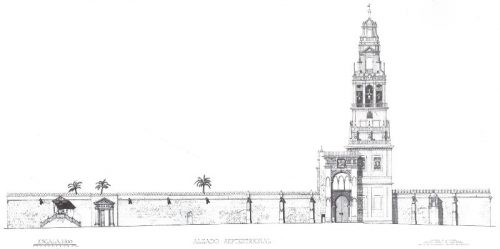
North Top
The minaret was built in times of Abderramán III and today is kept in the interior of the bell belfry. Damaged after a storm, it was arranged by the Cathedral Chapter in 1593. Hernán Ruiz Ii carried out the project, demolishing part of the old minaret and built the bell tower. In the seventeenth century work they continued under the command of Juan Baquero Matilla, who built the torso clock. Faced with the danger of collapse are all better cemented by the end of the century. In 1664 Gaspar de la Peña made campanile. Finally, the figure of San Rafael there on the tower is the piece of work of sculptors Bernabe Gomez del Rio and Pedro de la Paz.
Rahman Mosque I (785)
The original mosque of Abderrahman I was 11 longitudinal aisles defined north-south management. In its structure shafts and Roman and Visigoth capitals for the germination of the columns they were reused. These pieces were placed at different heights as reference was made constructive rather roofline of the terrain. The orientation of the mosque is peculiarly oriented to the southward rather than towards Mecca, every bit occurs in the mosque of Damascus. The crusade of this is probably the configuration of the sandy banks of the River Guadalquivir. Due to this unorthodox counseling, prayer niche becomes a highlight of the interior of the mosque. Some other characteristic of the edifice is the use of horseshoe arches, typical of Visigoth art, and that Islam would be introduced in his fine art gradually until it unique and characteristic of its architecture. The arches that link the buildings are composed of two parts: horseshoe arches at the bottom and arches at the top. Another feature of the mosque and would create trend in Islamic art is the combination of rock and brick arches, detail that gives a unique chromatic architecture. The dual construction of overlapping arches brings upwards the interior space and allows better illumination of it. The origin of this type of action seems to be in the Roman channel of Los Milagros, Merida.
First Enlargement (821-852)
The prayer hall was expanded into eight sections allowable by Rahman Ii (822). They added 24 meters to the length of the mosque. This extension has a clear influence Abbasid decoration, due to the political bands which were established at that time with the Eastern Caliphate and the inflow of characters coming from the east to the territories of the peninsula. The architectural features of this extension have the same characteristics equally those of the first stage of the mosque: combination of stone and brick and alternating segments and arcs. The origin of the Puerta de San Esteban is unknown, although information technology could exist between aesthetically Visigoth art and the Caliphate of Córdoba. What it is known is that it took its final shape under the leadership of Mohamed I. Al-Mundhir up the treasury, from which its concluding location is unknown. Abd-Allah built a clandestine passage, or sabbath, which connects the mihrab in Alcázar de Córdoba. The foundations of the mihrab of this stage is found in the basement of Villaviciosa. This finding brought to calorie-free the monumental graphic symbol of the mihrab, which was set upward under a large curvation supported by four columns and protruding from the outside of the wall of the qibla. At this time also they closed with saqqifas the sides of the patio.
2nd Expansion (Due south. Ten)
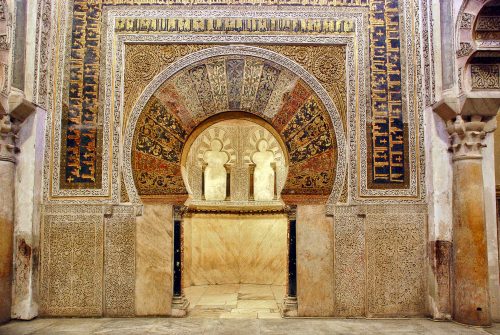
undefined
In 929 Córdoba capital became more than important in the Islamic world from the Due west to come up to ability the caliph Abd al-Rahman III. At this time a new minaret was built and the courtyard of the mosque was expanded. With these works the first minaret of the Due west, which would serve as a model for Almohad Moorish minarets and steeples was created. Currently the minaret is inside the Christian bong tower, and although no longer can encounter their appearance, the drawings and by the testimony left past the relief of the spandrels of the Puerta de Santa Catalina is known. Because the thrust of the ships, the arches that communicate the courtyard of ablutions with covered oratory deformed, then Abderramán 3 sent to reinforce them. He as well ordered the structure of a big horseshoe arch over existing at the front door of the mosque coming from the patio, and including a barrel vault.
Later in the century, under the Caliphate of Al-Hakam II, civilisation and the aesthetic and literary arts was encouraged. Besides cultural and political contacts with Byzantium, the great capital letter of the eastern caliphate multiplied. This splendor as well led to the richest phase in the evolution of the mosque.
Under the control of two sections Alhakem II to the mosque, bringing it closer to the river Guadalquivir added. This expansion marked the final depth of the mosque, leaving equally we see today. This fourth dimension specially commissioned materials were used for the work, instead of reusing materials from other buildings. The shafts of pink and blue marble are alternated. The capitals are of pads, a name given to the outlining of the capitals of classical orders and that would lead to the capitals of nest of Medinat Al-Zahra nowadays at Medina Azahara. In the terminate wall structure, or qibla, niche, or mihrab it is located, to which the true-blue directly their prayers. Considering of the pressures facing this wall was congenital from the beginning doubly to ensure its robustness. In front end of the mihrab is the monumental whole maqsura. To overcome the lack of lighting in this area, a number of vaults with skylights that let in light for illuminating the most important signal of the mosque were placed. I of these skylights is located on the Chapel of Villaviciosa. The other three are in front end of the qibla wall, forepart and sides of the mihrab.
The vaults are formed past thick ribs that go out space betwixt them. This solution would later called Caliphate vault ribs, and would be used later in the Mudejar style. Maqsura ornament consists of carved marble baseboards where there ornamentation of Syrian origin. There is too beveled tiles. All this gives the whole similar to the Byzantine, where the diverseness of colors is characteristic fashion. The mihrab is octagonal and is closed by a dome-shaped beat.
Third Extension (987)
At the finish of the century X Almanzor conducted the last major extension of the building of the mosque of Córdoba. The poverty of the materials of this extension denotes the next autumn of the caliphate. Due to the location and nearby mosque river, Almanzor decided to expand eastward, adding 8 more ships in that management. To carry out these works Almanzor had to expropriate the houses they occupied this area. The reform of the mosque also caused the mihrab quedase offset. Qibla no longer built double. Finally, the color range of the arches, it is no longer in this area due to the combination of rock and brick. The arches are made entirely of limestone, painted red where appropriate to go on with the appearance of the previous phases of the temple.
Cathedral
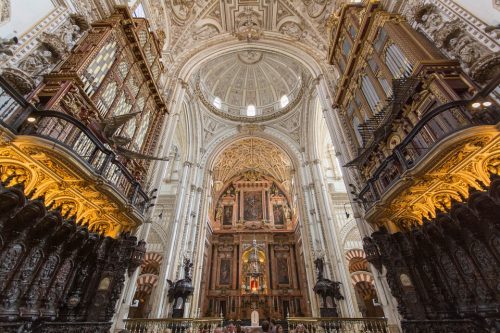
undefined
The cathedral has a Latin cross, and protobarrocas Gothic vaults and a Renaissance dome. The altarpiece, finished in the seventeenth century, is marble. Pulpits, on both sides of the main arch, are the eighteenth century and are made of marble and mahogany, past the sculptor Miguel Verdiguer. The choir stalls, as well of the eighteenth century, is the work of the Sevillian master Pedro Duque Cornejo. Carved and sculpted in mahogany, representing various subjects. Another important creative value is the Treasury. After the Capilla del Cardenal Salazar is the cathedral collection, formed by pieces of ivory and silverish fabricated between the fifteenth and twentieth centuries. Among them is the part of the custody of Corpus Christi, designed by Enrique de Arfe held in the sixteenth century.
Due west front
- Postigo de la Leche
- Puerta de los Deanes
- Puerta de San Esteban
- Puerta de San Miguel
- Gate of the Holy Spirit
- Postigo del Palacio
- Puerta de San Ildefonso
- Sabat door
Eastward facade
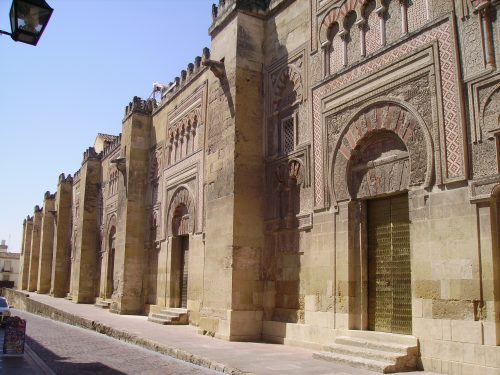
- Circular door Grada
- Fuente de Santa Catalina
- Puerta de Santa Catalina
- Puerta de San Juan
- Gate of the Baptistery
- Puerta de San Nicolas
- Gate of Aboriginal Conception
- Puerta de San José
- Puerta del Sagrario
- Gate Jerusalem
North side
- H2o Arca
- Door of Forgiveness
- Puerta del Caño Gordo
- Fuente del Caño Gordo
- Virgin of Lanterns
Southward facade
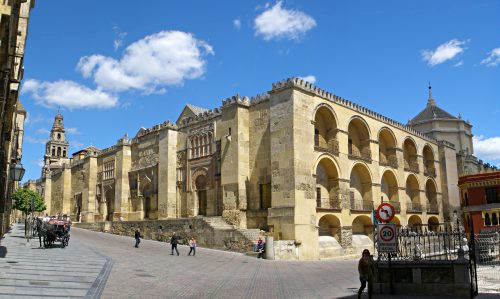
- Balcones
- Balcon de San Clemente
Capillas
- Chapel of Villaviciosa
- Capilla Real
Chapels on the west wall (n to south)
- Chapel of San Ambrosio
- Capilla de San Agustin and Santa Eulalia de Mérida
- Chapel of Our Lady of the Snows and San Vicente Martyr, as well known as Chapel of the Transfiguration
- Chapel of Saints Simon and Jude
- Chapel of Our Lady of Conception and the Blessed Sacrament
- Chapel of San Antonio Abad
- Trinity Chapel
- Chapel of San Acacio
- Chapel of San Pedro and San Lorenzo
Chapels on the south wall (due west to east)
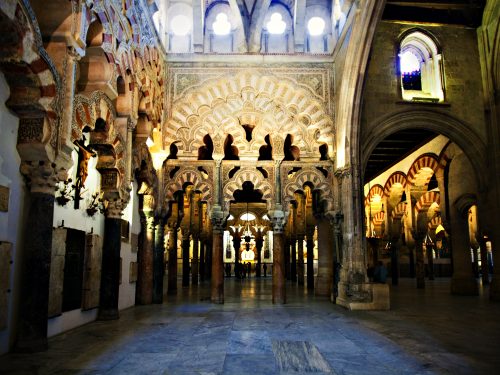
- Chapel of St. Bartholomew
- Capilla de San Felipe y Santiago
- Capilla de Santa Teresa, also known as a chapel or chapel of Cardinal Salazar Treasury.
- Capilla de Santa Inés
- Chapel of San Clemente, which houses the Museum of San Clemente
- Capilla del Sagrario
Chapels on the eastward wall (north to south)
- Capilla de San Antonio de Padua
- Capilla de San Marcos, Santa Ana and San Juan Bautista
- Chapel of San Mateo and Immaculate Formulation of Our Lady
- Chapel of San Juan Bautista
- Chapel of Santa Marina, San Matias and the Baptistery
- Chapel of St. Nicholas of Bari
- Expectation Chapel, also called Chapel of Our Lady of O
- Chapel of the Holy Spirit, as well chosen Simancas chapel or chapel of Bishops.
- Antigua Formulation Chapel, likewise called Capilla del Rosario.
- Capilla de San José
- Chapel of the Nativity of Our Lady
- Chapel of St. Mary Magdalene
- Sacristy
Chapels on the e wall (westward to eastward)
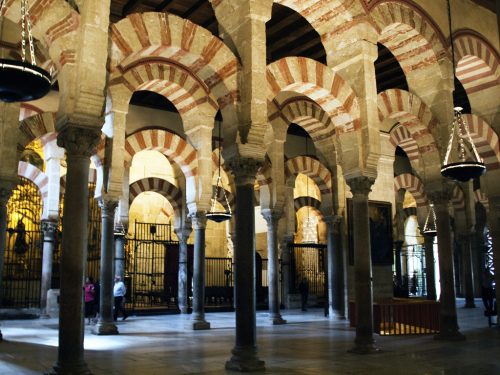
- Chapel of San Eulogio, also called Chapel of San Miguel
- Capilla de San Esteban
- Chapel of Our Lady of Suffering, also chosen Chapel of St. Mary Magdalene
- Chapel of Our Lady of Antigua
- Capilla de San Andrés
- Chapel of the Epiphany, also called Chapel of the Magi
- Chapel of Our Lady of the Rosary
- Chapel of the Holy Souls in Purgatory, also called chapel of Inca Garcilaso
- Chapel of the Holy Men, too called Chapel of the Holy Sepulchre
- Chapel of St. Frances of Rome and St. Ursula
Structure and Materials
The structure of the mosque is made with columns and arches of unlike styles on the cover supports. Inside the mosque are both Moorish arches and semicircular and lobed. The most characteristic characteristic of his prototype is the combination of two materials, rock and brick. 1,300 columns likewise learn different shades due to the variety of types of rock were used in the different phases of structure of the mosque: marble, jasper and granite. The roof, wood is carefully preserved and renovated because that has been repeatedly threatened by termites. Also noteworthy are the ornamental plaster work, specially in the mihrab. It consists of a base of marble, stucco and richly colored on a background of aureate, bronze, silver and copper Byzantine mosaics. In the cathedral worth admiring the work and details of the ceilings and carved choir stalls made of mahogany.
Videos
Source: https://en.wikiarquitectura.com/building/mosque-of-cordoba/
Post a Comment for "Great Mosque of Cordoba Plan Drawing"